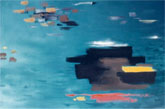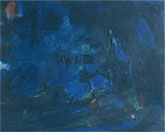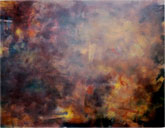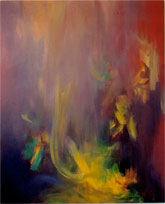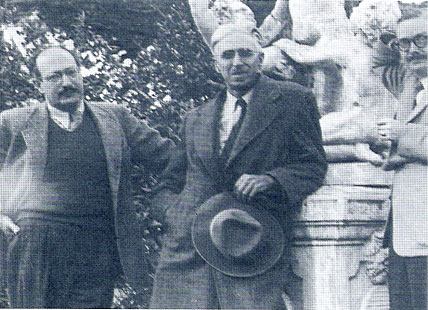"Spohn’s, The Ballet of the Elements (front cover). The San Francisco art critic, Tom Albright described this painting exhibited with the best works of West Coast painters including Mark Rothko and Clyfford Still in 1973: "[the painting] with its stripe-like allusions to landscape under a ‘sky’ of fluid, shorthand squiggles, is altogether unique in this context (i.e. the projection still of the fervor, the desperation, the iconoclasm and ethical commitment etc. that went into them) and perhaps for that reason stands out as the exhibition’s most monumental single masterpiece." ideal reference source for libraries"
San Francisco artist Clay Spohn (1898--1977), one of the best artists of the modern era,originated art movements of the twentieth century and painted with great beauty. Using Spohn's Notebooks, David Beasley has traced his thought and career. This book is amply illustrated with Spohn's drawings and paintings placed to elucidate the text. Many paintings are in color as Spohn used color superbly.
TESTIMONIALS
Spohn knows a lot about modern art and what he knows he has straight.
Walt Kuhn,artist, as quoted by Ralph Stackpole, sculptor.
Spohn has always been close to the spirit of dada and surrealist outrage, turning rage outward into delight and a benign sense of shock that would express the sense of humor that he felt was the core of the modern art impulse .... I consider David Beasley's monograph on the work of Clay Spohn one of the most moving documents I have read on an artist, revealing a compassion and sense of justice rarely encountered in the field of aesthetics. If this could be expanded into a book with color reproductions and further documentation I think a memorable achievement will occur.
John Hultberg, artist,
At long last! Clay Spohn, one of the really great artists of the 20th century, is about to become known .... Here was a Renaissance man full of humor and good will and rather shy.... Clay was a leveling influence at the C.S.F,A.—a softener to Clyfford Still's negativity and megalomania,
Walt Kuhlman, artist,
Spohn's paintings from his Taos years invite interpretation as allusions to psychological states of being in more than one space-time at the same moment. By then he had attained the ability to picture the ambivalence of simultaneously different locations in space and time and the results were deeply engaging and illusive.
Wesley Rusnell, Curator, Roswell Museum and Art Center, New Mexico,
I feel that this book would be an important addition to art historical scholarship of this period, especially with a sufficient number of color reproductions that would do Spohn's work justice,
Michael Schwaeger, Director, University Art Gallery, Sonoma State University, California,
I do most enthusiastically welcome and support the idea of a book about Clay Spohn. The wonder is that it has not been done before, He was a great person and marvelous artist.
Hassel Smith, artist.
A full treatment of the career of Spohn strikes me as being of importance to the art history of this country.
David Witt, Curator, Harwood Foundation, New Mexico
Clay Spohn was one of the most important influences on me and my work ... not only me but many others.... The combination of originality and imagination, and wit, and care Clay brought to everything he did ... all this needs to be known.
Frank Lobdell, artist,Head, Department of Art, Stanford University, California,
Although little has been written about him, Spohn was among the most influential artists of his generation, Beasley's study strikes a nice balance between personal insight and an art historical treatment of Spohn's work.
Susan Landauer, Historian of Modern Art.
I heartily recommend the work of Clay Spohn and know him to have been a dedicated artist, worthy of recognition even though posthumous.
Richard Diebenkorn, artist.
Everyone loved Clay (for his personality), He was a party favourite, He could never afford his own bottle—-but he could drink with the best of them (Ed Corbett and BobCreally).
Judson Crews, poet,
Clay Spohn is a superb teacher and painter but not recognized.
Ed Corbett, artist,
He is a professional artist of the sharpest distinction, and a teacher of wide range and inspiration.
Paul Forster, artist,
visual arts NOTABLE BOOK
This eminently readable, vivid account of the American artist, Clay Edgar Spohn (1898-1977) provides numerous revelations about modern art, isms, and art institutions. It is a chronicle that skillfully interweaves the artistic developments of an individual with the movements and attitudes in society as a whole. Spohn's early years reflected the classical biographical scenario of conflict between the pursuit of material stability encouraged by his father and the pursuit of a "calling" as encouraged by his artist mother. Clay's parents attempted to contain his spirit and natural bent through stints with the Augusta Military Academy in Virginia and enrollment in economics at the University of California in Berkeley. They finally yielded and agreed to finance hisstudies at the New York Art Students League, where he arrived from San Francisco in1922. Rigorous training based on academic European tradition, from visionary teachers such as Kimon Nicolaides, George Luks and others, assured Spohn a means of livelihood through art commissions like illustrations, murals, and commercial advertising.While there, Spohn also met fellow student Alexander Calder whom he befriended later during his Parisian stay. Ever the magnet for artists, Paris proved a crucial and far reaching experience for Spohn. He immersed himself fully in the cultural milieu of Parisin the '20s, and expressed his own ideas and interpretations in a variety of forms and media, well exemplified in the black and white images throughout the text. The significance of Calder and Spohn's friendship and dialogue is emphasized and brings to mind other associations, such as Braque and Picasso, Van Gogh and Gaugin or Seuratand Signac, whether amicable or not, because of their own development bearing on historic events. When he returned to San Francisco in 1927, he submitted works to annual art shows, designed and executed murals for Federal Art Projects (1935-42) and never ceased to experiment in forms of abstraction in sculpture, painting, banners and satirical "constructions-inventions", which succeeded in upsetting the "staidness" of most San Francisco society. However, this quest of freedom of expression for the artist was not lost on Douglas MacAgy, Director of the California School of Fine Arts. At his invitation, the 46-year-old Clay Spohn found himself teaching there, alongside Mark Rothko and Clifford Still to "lead students away from Social Realism and the old way of thinking.'' By 1948 the gap between East (N.Y.) and West (Calif.) was closing as Abstract Expressionism became a recognized "School" and Marcel Duchamp's anti-art was being transcended by Spohn's Assemblage-art, Pop Art and "Found Objects. "These works culminated in his "Museum of the Unknown and Little Known Objects" (pp.66-67), an exhibit for which he was assisted by his colleagues Richard Diebenkorn and Hassel Smith. In five years' time the team of Still, Rothko, Spohn, David Park, Diebenkorn and others made The California School of Fine Arts in San Francisco world renowned,but with the return of a more conservative board, all but Park and Diebenkorn returned to New York. "The most obvious difference that set Spohn apart from other abstractionists was his constant revolution whereby, as he perfected one mode of painting, he overturned it with another mode," observes Beasley. Whereas Still and Rothko (as well as others) had found their style or a "blind alley" as Spohn noted,he remained true to "his pursuit of pure personal expression" regardless of where it might lead him. This philosophy was reflected in his paintings of the Taos N.M. period and especially in the "pure paintings" from New York City, 1961-1965, such as "Dark Painting with Red and Yellow" (p. 10), "Blue Abstract" (p. 12) and "In the Bright Light of the Living Moment" (p. 16). By the early 1970s, however, he was obliged to request funding from the Rothko Foundation. Despite occasional sales and the "promise" of serious acknowledgement through exhibits and retrospectives, he remained largely misunderstood by the public and the art establishment. And he was now in failing health. In a final twist of irony, the New York Times did not find him worthy of inclusion in their obituary section. And yet, four days after his death, a notice was delivered announcing the approval of a grant awarded him by the National Endowment for theHumanities. Beasley concludes: "The frustration of the artist who tries and fails to communicate and educate cannot be fully appreciated by the rest of us." This sensitive portrait of Clay E. Spohn mirrors again the fate of artists such as Rembrandt, Van Gogh, Camille Claudell, and Canadian Emily Carr, who "follow their own direction" without compromise to the establishment of the day or the market, and present a challenge to contemporary society.
Reviewed by Maria Maryniak - The Downtowner, St Catharines, ON
